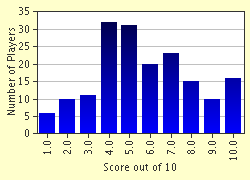Quiz Answer Key and Fun Facts
1. In 976 AD the Margraviate of Austria was created by Otto I, Holy Roman Emperor, to secure his empire's eastern frontier. The title of Margrave was given to this man - founder of the Babenberg dynasty. Who was it?
2. In 1156 AD Frederick I Barbarossa, Holy Roman Emperor, elevated Austria to the status of a Duchy. His cousin had already performed the functions of margrave since 1141 AD and was delighted with his new titles. Which individual was it?
3. This Duke was insulted by Richard I Lionheart, King of England, during the last days of the Third Crusade's siege of Acre (Jun 1191 AD). The leadership of the German contingents had fallen on him after the deaths of Frederick I, Barbarossa, Holy Roman Emperor, and his son, Frederick, Duke of Swabia, in 1190 AD and 1191 AD respectively. He returned to Austria seething for revenge soon after the capture of the city. Which individual was it?
4. Upon the death of Duke Frederick II, the Fighter, in 1246 AD, the Babenberg dynasty ended and direct imperial control over the Duchy was imposed by this Holy Roman Emperor. Who was it?
5. In 1253 AD this King of Bohemia claimed the Duchy of Austria through his marriage to Margaret, sister of the late duke, Frederick II, the Fighter. He would struggle with Rudolf I, Holy Roman Emperor, over control of the duchy til he was defeated and killed during the Battle of Marchfield Plain (Durnkrut) on Aug 26, 1278 AD. Which individual was it?
6. In 1276 AD Rudolf I, Holy Roman Emperor, took over possession of the Duchy of Austria. It would remain in his dynasty's possession til 1918 AD. Which dynasty was it?
7. In 1519 AD the grandson of Maximilian I, Holy Roman Emperor and Archduke of Austria, assumed both of his grandfathers titles and duties. He would turn over control of Austria to his brother, Ferdinand I in 1522 AD and finally abdicated the imperial throne in 1556 AD. Which Archduke was it?
8. In 1740 AD the War of Austrian Succession began when this individual succeeded their father, Archduke Charles III. Which individual was it?
9. In 1804 AD the Austrian Empire was declared by this archduke in response to Napoleon Bonaparte's declaration of a French Empire earlier in the year. The archduke feared that Napoleon I would dissolve the Holy Roman Empire and take over control of the lesser German states and he wished his family to retain the prestige of an imperial title which it had held since 1438 AD. Which Archduke was it?
10. After being defeated in the Seven Weeks' War (1866 AD) and excluded from the new North German Confederation (1867 AD) the Austrians were forced to turn their attention towards their holdings to the East. In 1867 AD the Austrian Empire was declared a dual monarchy with Hungary. This was to gain the support of the Hungarians by making them equal partners in the empire (they had always resented German rule). Who was the Austrian Emperor who proclaimed the new arrangement?
Source: Author
hund
This quiz was reviewed by FunTrivia editor
Terry before going online.
Any errors found in FunTrivia content are routinely corrected through our feedback system.

